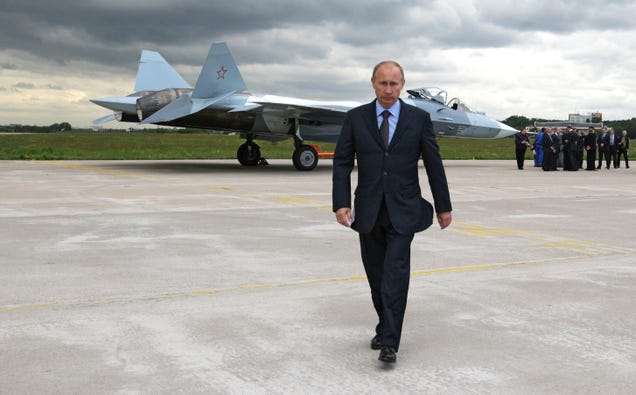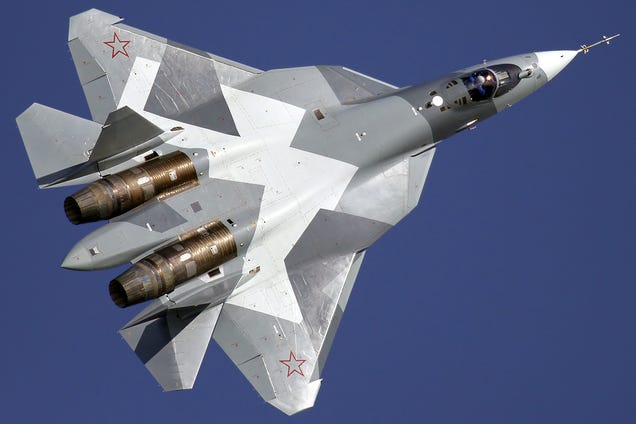
Posted on 07/17/2015 8:34:36 PM PDT by sukhoi-30mki

Russia may be coming to the realization that developing a high-tech weapon system is not the same as fielding it en masse, or even in relatively limited numbers. This appears to be the case for both the T-14 “Armata” tank, the T-50 5th generation fighter, and signs are possibly the PAK-DA next generation bomber.
The T-14 has been Russia’s most celebrated new weapon system as of late. Regardless of its capability (though it’s by no means a “silver bullet” weapon system), in order to be really effective it needs to be fielded in relevant numbers. Originally the idea was to replace the majority of Russia’s front-line stable of ‘legacy’ main battle tanks with the T-14, amounting to about 2,300 in total, with production ramping up in the short term.
Instead of producing thousands of the tanks over next five years or so, some analysts put the number as little as a few hundred. This is partly because the cost of the tank has ballooned to about two and half times what was originally projected. As a result, the Kremlin will likely focus on modernize existing system, such as its T-72 and T-90 tank force.

The same situation is also occurring with the Kremlin’s new stealthy fighter, the Sukhoi T-50. Originally the Russia was aiming at building about 150 T-50s by 2020, then the number was scaled back to just 52 units with the first batch entering operational service in 2016. Now, that number is being drastically scaled back once again to just 12 aircraft, which really equates to an expanded test and operational validation force at best. What’s worse is that as production numbers plummet, unit costs increase. This is what is commonly referred to in Pentagon parlance as a weapons program “Death Spiral.”
India, which has invested partially in the T-50 project (also referred to as the PAK-FA) for its own derivative of the jet, has also been less than enamored with its progress and capabilities. Not to mention that the Indian Air Force just spent billions of dollars on 36 French Rafale fighters with more almost certainly on the way.
Then there’s the fact that there are tensions between the two nations when it comes to maintaining Inida’s existing Su-30MKI fleet. Spare parts availability and engine reliability have also been of major concern when it comes to India Su-35MKIs. This, along with other major recent purchases by India of aircraft made by western aerospace manufacturers, leads many to believe that New Delhi may turn away from Russia for its military aircraft needs.

All this equates to a fighter program that may slow to snail’s pace. As such, it then blurs the lines between a very costly research and development experiment and an actually viable front-line weapon system that Russia can hang its air combat helmet on for the foreseeable future.
Finally, we get to Russia’s next-generation bomber, the PAK-DA. Recent declarations that Russia will be putting the Tu-160 Blackjack back into production may be telling as to the future bomber’s feasibility. The choice to put a Cold War era bomber, one that was highly expensive back then and will be now, while also upgrading their existing force, seems like odd choices for an air arm that supposedly has a cutting edge bomber that will be flying by the end of this decade and coming online operationally around the middle of the next.

Part of this is just a numbers game and part of it is a reality — or lack thereof — game. Russia has been hit by sanctions in a way that is directly affecting their weapons procurement strategy, there is no doubt about it. This was not planned for five years ago or more when many of these programs were being launched.
Still, the valley between what Russia says it can do economically and what it actually can do is so wide that sanctions alone can’t explain the massive slowdown in Russia’s military modernization. It’s clear that Russia is simply unrealistic when it comes to its military technology ambitions.
This is hardly an uncommon phenomenon. The Pentagon has its own woes in this regard as well, although the unraveling of so many key and trumped up programs so fast has not been seen when it comes to the U.S., even in the Department of Defense’s post sequester reality.
With all this in mind, we will probably see just enough T-14s and T-50s to participate in parades, flyovers and to spearhead military exercises, but Russia will most likely continue to fall back on procuring and updating existing conventional weaponry while drastically updating their submarine and land-based nuclear capabilities. This offers a maximum “bottom line” deterrent while also maintaining a usable and affordable conventional force. It also allows Putin and the Kremlin to continue on without losing clout with the Russian people by not having to fully cut leading-edge programs seen as a national source of pride and international competitiveness. And it allows Russia to continue to parade around these programs while actively trying to sell them to anyone with who will buy into them.
This more rationalized approach to weapons procurement is not unlike that of the Cold War. We often forget that even at the height of tensions between East and West, America had to buy the F-16 and F-15 due to budgetary limitations, and that is just one example. A high-low capability mix was a strategy of necessity as much as anything else. The same was true for the USSR to an even greater degree, where numerical advantage was chosen more over a qualitative one.
The policy of procuring an almost all gold-plated, maximum capability at seemingly any cost force is an advent of the post-Cold War military industrial complex. It remains as unrealistic as it was in the Cold War, for both the U.S. and Russia. Russia is now having to come to terms with this reality, while the U.S. is not... yet.
You mean the Russkis haven’t learned to fake it like The Great Obozo does when he redistributes wealth (while pocketing some to make himself now filthy rich) to the Obama electorate, illegal aliens, and other chosen winners, etc., the wealth that otherwise does not exist because the US government treasury is in a deep hole of debt and near collapse?
So much for the quantity has its own quality Red Army mantra.
Perhaps the writers assumptions are wrong.
Russia is not designing and producing new weapons to use. The new weapons are designed and produced to sell.
Russia has no export products worth a damn except weapons. Weapons are russia’s manufacturing strong suit. Therefore, the new stuff is for customers.
But will they really? All that Iranian oil entering market next year should bring the oil price down and Russia is a petrostate.
Oil export consists 18% of total Russian export. Main Russia’s woe is liberal government implementing orders of IMF and Washington.
http://atlas.cid.harvard.edu/explore/tree_map/export/rus/all/show/2013/

Disclaimer: Opinions posted on Free Republic are those of the individual posters and do not necessarily represent the opinion of Free Republic or its management. All materials posted herein are protected by copyright law and the exemption for fair use of copyrighted works.